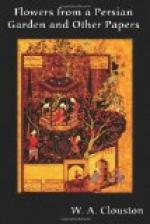As analogues, or variants, of incidents in several wide-spread European popular tales, other Hebrew legends are cited in some of my former books; e.g.: The True Son, in Popular Tales and Fictions, vol. i, p. 14; Moses and the Angel (the ways of Providence: the original of Parnell’s “Hermit"), vol. i, p. 25; a mystical hymn, “A kid, a kid, my Father bought,” the possible original of our nursery cumulative rhyme of “The House that Jack built,” vol. i, p. 291; the Reward of Sabbath observance, vol. i, p. 399; the Intended Divorce, vol. ii, p. 328, of which, besides the European variants there cited, other versions will be found in Prof. Crane’s Italian Popular Tales: “The Clever Girl” and Notes; the Lost Camel, in A Group of Eastern Romances and Stories, p. 512. In Originals and Analogues of some of Chaucer’s ’Canterbury Tales’ (for the Chaucer Society) I have cited two curious Jewish versions of the Franklin’s Tale, in the paper entitled “The Damsel’s Rash Promise,” pp. 315, 317. A selection of Hebrew Facetiae is given at the end of the papers on Oriental Wit and Humour in the present volume (p. 117); and an amusing story, also from the Talmud, is reproduced in my Book of Sindibad, p. 103, note, of the Athenian and the witty Tailor; and in the same work, p. 340, note, reference is made to a Jewish version of the famous tale of the Matron of Ephesus. There may be more in these books which I cannot call to mind.
AN ARABIAN TALE OF LOVE.
Lovers and madmen have such seething brains,
Such shaping fantasies, that apprehend
More than cool reason ever comprehends.
Midsummer Night’s Dream.
Every land has its favourite tale of love: in France, that of Abelard and Eloisa, in Italy, of Petrarch and Laura; all Europe has the touching tale of Romeo and Juliet in common; and Muslims have the ever fresh tale of the loves and sorrows of Majnun and Layla. Of the ten or twelve Persian poems extant on this old tale those by Nizami, who died A.D. 1211, and Jami, of the 15th century, are considered as by far the best; though Hatifi’s version (ob. 1520) is highly praised by Sir William Jones. The Turkish poet Fazuli (ob. 1562) also made this tale the basis of a fine mystical poem, of which Mr. Gibb has given some translated specimens—reproducing the original rhythm and rhyme-movement very cleverly—in his Ottoman Poems. The following is an epitome of the tale of Majnun and Layla:




